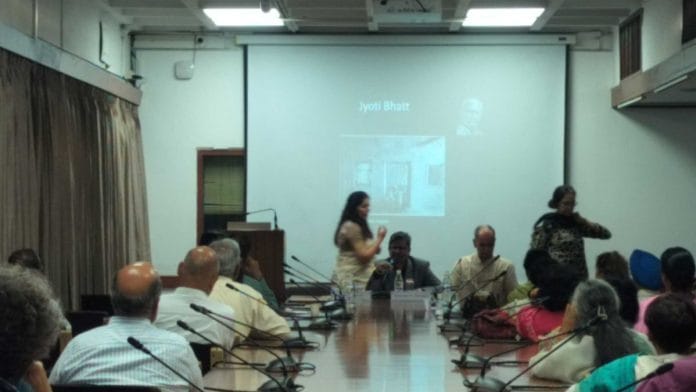New Delhi: Conference room number one at New Delhi’s India International Centre resounded with ‘oohs’ and wows as contemporary artists set to represent India at the prestigious Art Santa Fe and World Health Congress in New York later in July presented their artwork to a mesmerised audience.
On display were the paintings of Sanjeev Kishor Gautam, Director General of the National Gallery of Modern Art, eminent artist Arpana Caur, and India Art Circle grantees Neerja Chandna Peters and Renuka Sodhi Gulati.
The artists will represent Indian art at galleries curated by Gargi Seth in Santa Fe as well as New York. The theme of the exhibition is Global Perspectives with Local Roots, representing contemporary art inspired by Indian folk and traditional art.
“I have noticed artists that always appeal to audiences are the ones who are connected to their local roots. A certain groundedness makes their art special,” Seth, curator with India Art Circle, said.
The art and the artists
The four artists brought a glimmering variety to the table. Gautam showed 2-3 paintings and added that he draws inspiration from the wall art of Hazaribagh, taking inspiration from its motifs, techniques, and strokes.
Senior artist Arpana Caur remarked that very few artists combine “roots and contemporaneity” and displayed a painting where Warli-like figures appeared inside a horse or an elephant. She added that 30 years ago, she had started adapting this work to the human form.
“The inspiration behind multiple figures within one figure I got from the tradition of Nari Kunchacko,” she said.
Another painting depicted humans as ‘nature’s harvest’, using harvest motifs from Warli art.
One depicted night and day, telling the story of Jangarh Singh Shyam, the father of Gond Art who was kidnapped by a Japanese art dealer. There was a mask-like figure in the middle of the painting, depicting the shock and horror of his wife, inspired by Madhubani art.
“[The] sad thing is Madhubani artists continue to go through the same dealer because he is able to sell their art,” Caur said.
Peters showcased geometric art drawn from her love of math and geometry as a child. “When I started dabbling in art in 2010, I tried all genres to acquire the skill till I found my language in geometry,” she said. Her work uses triangles, circles, density of lines and angles to create reflection of light, as she wants her art to also reflect sunrise, a view she is inspired by.
Her abstract geometric series created its own rainbow of colours that draw a viewer to them. She wants to convey meditativeness and spirituality through her art, which an American art historian has compared to teachings of the Brihadaranyaka Upanishad.
Gulati’s artwork draws from nature and often focuses on one element to tell her story. “My journey began with using a single leaf, and my first exhibition was showcasing the elements of space through a single leaf,” she said.
Her choice of single element this time is a log of wood, through which she shows dynamic Indian wildlife, growing from it. She also showcased art combining natural elements with the woman form as the protagonist of the story.
Also read: Madras artists were latecomers to Indian modern art. A Bengal painter & a critic pushed them
Attention to traditional visual art
While the gathering present at the small conference hall celebrated contemporary as well as traditional Indian art, senior artists raised concerns about the neglect of traditional art and the sidelining of visual artists on global platforms.
Gautam insisted that traditional art forms should find a place in art school syllabi. “I am sorry to say that we don’t provide any space to Indian folk and traditional art in our art schools.”
Amrinder Kathua, former director general of the Indian Council of Cultural Relations (ICCR) highlighted that the export of performing and visual arts has dipped.
“India exports $230 million worth of art colour and paper; we export materials more than visual arts,” he said.
He advocated for India to take its traditional and modern art to the global marketspace. “We have a diaspora of 24 million. How come our visual arts are not being sold there?” he asked, highlighting that 70 Indian regional associations in the United States often invite performing artists but not visual artists.
Kathua highlighted how the four Indian artists participating in the Santa Fe festival have broken the glass ceiling. “As many as 265 Chinese visual artists participate at Santa Fe. Even small countries like Kenya send 32 people. And we’re going there for the first time,” he said.
Caur said that even institutions like the ICCR promote performing artists over visual artists, highlighting the helplessness of the latter. “Where do visual artists go and complain?”
(Edited by Humra Laeeq)






